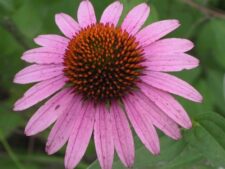
This is the most robust and showiest of the purple coneflowers, a much branched perennial up to 5 1/2 inches tall. The toothed, alternate, lance-shaped leaves are widest near the base, and up to 8 inches long and 6 inches wide becoming progressively smaller above. Arising from the tip of the stems are individual flower heads 2 1/2 to 5 inches wide with drooping, petal-like reddish-purple to pink ray florets surrounding a dome-shaped head of disk florets and prominent, pointed bracts (A,C). Disk florets contain yellow pollen (B).
This tallgrass prairie plant is quite far west of its natural range, which just extends into southeast Iowa. It flowers from June through September. It is common in prairie restorations at both Fontenelle Forest and Neale Woods.
The large flowers with broad ray florets, smooth flowering stem and broader, toothed leaves separate this plant from our other Echinaceas.
This showy, long flowering species is widely planted as a garden ornamental and is often used in wildflower seed mixes. Native Americans likely used plants of the genus Echinacea more than any other for a variety of afflictions including venomous bites, burns and sore throats. Early practitioners thought it increased resistance to infection, and it remains a popular component of herbal remedies to this day.
Other common names include Red Sunflower and Black Samson.
The content of NatureSearch is provided by dedicated volunteer Naturalists of Fontenelle Forest who strive to provide the most accurate information available. Contributors of the images retain their copyrights. The point of contact for this page is: Neal Ratzlaff.

 Identification
Identification
